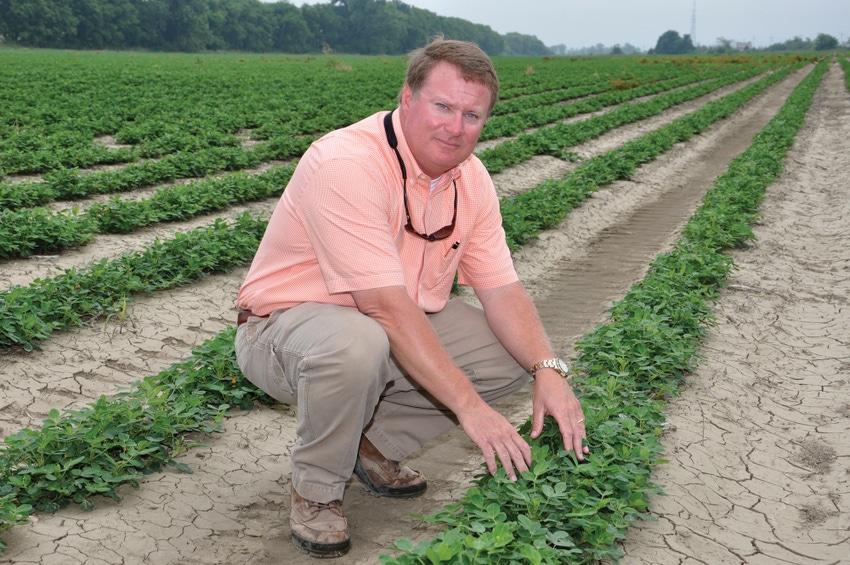
Over 50,000 acres of peanuts have been planted in Mississippi this season thanks to good prices. But Tunica, Miss., producer Justin Cariker had another reason.Cariker was looking to take some of the stress off his his new John Deere round bale picker, and peanuts provided the gross revenue he was looking for.

Thanks to high prices, Mississippi producers have planted an estimated 50,000 acres of peanuts in the state this year, more than triple the acres planted in previous years and the most acres since 1943. But it’s not just the price of peanuts that interested Tunica, Miss., cotton producer and former Delta States High Cotton Award winner, Justin Cariker.
Cariker produces soybeans, cotton, rice, wheat, corn, and now peanuts, on about 5,000 acres just south of Tunica, Miss. “The first thing that got me thinking about peanuts was the John Deere 7760 cotton picker,” Cariker said. “We got rid of our two conventional cotton pickers and the boll buggies and module builders and bought John Deere’s round-bale picker.”
Last year, Cariker put 2,700 acres on the John Deere 7760, a few more acres than he felt comfortable with. “We got by, but John Deere said the optimum acres with the round-bale picker is about 2,200 acres. So I needed an alternative crop that grossed out well for me. I already had one corn combine maxed out on 1,000 acres of corn, and soybeans don’t provide enough gross return. So I decided to plant 300 acres of peanuts.”
Cariker is one of a handful of producers around Tunica who are planting peanuts this year. All have contracted their peanuts at very good prices with Birdsong Peanuts, Aberdeen, Miss., which will provide transportation of the harvested peanuts and weekly scouting. Alan Blaine, an independent consultant and former Mississippi Extension soybean specialist, also helps with advice on production practices.
The crop did not require a lot of investment for Cariker, who purchased a new digger and peanut harvester for around $140,000.
Cariker began by making sure he had enough sandy ground to plant 300 acres in a three year rotation with cotton and corn. “The peanuts will grow on any type of soil,” Cariker said. “But I’m hearing you need to put them on sandier soil to dig them.”
The rotation program should help bump yield in all three crops, and keep disease pressure from building in peanuts. All the peanut ground is dryland. Cariker’s initial goal is to harvest 2 tons to 2.5 tons of peanuts per acre.
Cariker subsoiled peanut ground in the fall of 2011. In January, he bedded up on 40-inch centers and rolled the beds.
Cariker applied Valor on peanut ground in January and Valor and Dual at planting. “We came back 14 days after emergence over-the-top with Dual, Basagran and Gramoxone with 20 gallons of water. We had to hit them with Select for johnsongrass. We’ll also had to hoe out a few acres of pigweed.”
Planting was a big hurdle for Cariker, especially considering how fast the operation had become in other crops. “In peanuts, you plant about 120 pounds an acre at 3 miles per hour. You’re spraying inoculants in-furrow and Thimet. We had gotten away from most of the in-furrow applications at planting with our other crops, planting at 6 miles per hour and 150 acres a day. That was something new. It took us four days to plant the peanuts with a John Deere air planter.”
Cariker started planting peanuts on April 16. “Birdsong was a little nervous about us planting that early, but it worked out okay. We finished planting around April 19. We didn’t have a full stand of peanuts until May 1. I was worried to death, but today I’m pleased with the stand. They say the peanuts should be ready for harvest around the second or third week of September.”
Cariker was expecting to make his first fungicide application in mid-June, and maybe one more. “We may have to put out one more herbicide over-the-top for morningglories, but that may be it.” He also made an application of boron.
Cariker will also have to be patient at harvest, as the process is slow relative to other Mid-South crops. “I hear that harvest is maybe 25 acres a day at best. That’s your limiting factor on how many acres you can handle. It will take us about 10 days to harvest the crop.”
Harvested peanuts will be trucked 150 miles to the Birdsong facility in Aberdeen, according to Cariker. “They furnish trucks, trailers and dump carts.”
There’s no doubt that favorable peanut prices played into Cariker’s decision to plant peanuts. “They tell us that the peanut contract price follows the cotton market. At the time the peanut contracts were out in January, cotton prices were above 95 cents. We were able to lock all of ours in at a good price. But there’s no telling where it will be next year if the cotton market is at 65 cents.”
For Cariker, shifting to peanuts was mostly a business decision based on equipment needs. “They fit into the puzzle. If my picker could do 3,000 acres of cotton, I never would have gotten in the peanut business. But I do believe peanuts in the rotation will benefit my cotton crop.
About the Author(s)
You May Also Like





